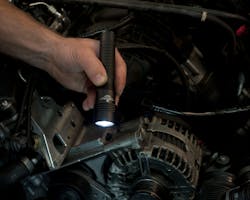Simply put, a technician cannot work efficiently if he cannot see what he is working on. So shop lighting – in various forms – is extremely important to keep service bays operating efficiently.
“If you can’t see it, you’re going to trip over it,” says John Schira of Maxxeon – a company that designs and builds cordless lighting tools. “If technicians are under a car and they’re using some sort of portable lighting and they can’t quite see what they’re looking at, they can’t do the inspection right.”
However, there is more to proper shop lighting than hanging fluorescent lamps or grabbing a flashlight out of the toolbox.
Types of lighting
“Technicians not only work in multiple areas on the vehicle – under the hood, under the car on a lift, etc. – they also work in unique environments,” explains Mike Monteleone, senior product manager for Milwaukee Tool – a manufacturer of heavy duty tools and accessories. “Because of this, they need several different types of lights.”
Don Burgstead, marketing director at ATD Tools – a provider of professional automotive tools, says that a variety of lighting should include handheld lights for vehicle inspections, underhood lights to illuminate the entire engine compartment for extended periods of time and flashlights or pocket lights for convenience.
Additionally, Eric Pike –director for automotive products at Streamlight, a manufacturer of various lighting tools – adds that headlamps can aid a technician’s work as well.
“Whether for maintaining or repairing cars or light trucks, today’s comfortable, lightweight headlamps give automotive pros the hands-free lighting they need, when they need it,” Pike says.
Maxxeon’s Schira says proper lighting throughout the shop is critical for technician safety. But he emphasizes the importance of quality portable lighting to increase productivity.
“Floodlight-style lighting in a worklight or a portable light is one of the most critical things,” Schira says, noting 60- to 180-degree beam angles are ideal. “You can imagine if (a technician) has an old-style flashlight, and he’s holding it a couple feet away, the beam diameter might be 4” to 6” wide. It’s not the tool for the job.”
Better technology, better productivity
Many of today’s lighting options perform at a higher quality thanks to advancements in battery and light technology. Arguably the biggest advancement is the use of light emitting diodes (LEDs).
“High-quality LEDs are rated at 50,000 to 100,000 hours of use. That’s six to 12 years,” says ATD’s Burgstead, noting LEDs are durable, generate less heat and can be more resistant to dust and water. “In addition, LEDs have significantly lower power consumption, which saves on electricity.”
Battery technologies, like the use of Li-ion power sources have progressed along with the development of LEDs.
“This, coupled with advancements in electronics, has led to more efficiency, more run-time, more light output and even more durability,” Milwaukee’s Monteleone says. “All of these improvements, ultimately, lead to greater productivity.”
Better features in handheld, headlamp and lantern lighting products also can help enhance shop efficiencies, according to Streamlight’s Pike.
“Recent advances in lighting technology are offering a wide range of new lighting tools and features for improving productivity, reducing costs and keeping workers safer on the job,” Pike says. “Owners should definitely stay abreast of these developments and update their existing equipment to enable workers to perform more effectively.”
Specs to consider
When outfitting an operation with new lighting products, shop owners need to consider what a lighting source will be used for specifically.
“Deciding what model to focus on should be based on the application,” Milwaukee’s Monteleone explains. “Do you need to light up a big area or simply diagnose a problem quickly under the hood?” Monteleone also says to consider how the product will be used. “Does it need to stand, hang from the hood, go in my pocket, etc.?”
What’s more, Monteleone says users may find value in having portable lights that operate on one battery system to consolidate the amount of batteries and chargers in the shop. “For this reason, users may ask what lighting options are available through a single manufacturer on one battery system.”
Streamlight’s Pike adds that USB-rechargeable flashlights are widely available and give professionals the ability to charge “on the go.”
“USB rechargeable lights save time and (help technicians) avoid the worry of not having batteries on-hand when they are needed most,” Pike says. “They offer a quick, easy and convenient way to recharge – workers can simply connect to a USB port or use an AC wall adapter.”
When making a lighting purchase, Pike also says shop owners should inquire about warranty support, cost of operation and breadth of the product line. Distributors should be prepared to answer any of these questions from customers.
Also, making sure a light is designed for the professional market is key, says ATD’s Burgstead. This can be done by making sure a product is approved by an OSHA’s Nationally Recognized Testing Laboratory (NRTL) program. Burgstead says shop owners “should look for lights that have the features and benefits they require, whether the light will be a handheld or underhood design, or a general purpose worklight.”
“Will the light be durable enough to withstand technicians’ everyday use, so their productivity is not impacted?” Streamlight’s Pike adds. “Can I meet all of my lighting needs from one supplier, in order to make it easier on the technician?”
Due to their lightweight, compact designs and power efficiencies, LEDs are the best option for portable lighting, according to Maxxeon’s Schira. But there are still several factors to consider before making a purchase.
“When they’re looking for portable lighting, the owners and techs need to consider how far away from the light source they are working,” Schira says. “What techs and shop owners have to keep in mind is the wide-beam angle – a flood-style beam. The wider the better.”
In addition to beam angle, shop owners should consider candela (the brightest spot on a focused beam), lumens and beam pattern, noting if there are any dark spots or other imperfections.
How to gauge a shop’s lighting needs
When distributors are visiting with a shop owner, they should ask questions about the current lighting set-up and inquire about any difficulties the technicians are having. If a customer is using incandescent or fluorescent lighting, tool dealers can inquire about how frequent bulbs need to be replaced, the current fixture’s run-time and if batteries need to be replaced often.
“The biggest emphasis should be on meeting the customer’s needs, not selling them a light that does not solve their lighting problems,” Streamlight’s Pike says. “They should probe as to whether the customer needs brightness (lumens) versus more focused, distance illumination (candela). Run-times are also important. Will the product do its job for the entire shift or should they consider options like dual-source lights that allow the products to run longer, thereby permitting workers to complete a full shift?”
In addition to explaining basic run-time, productivity and durability advantages, Milwaukee’s Monteleone says distributors can focus on cutting-edge features.
“Some manufacturers are utilizing the most advanced lighting technology so that the lights are optimized to accurately represent true colors and detail,” he says. “The user, therefore, experiences dramatically reduced glare, fatigue and eye strain for a more productive work area.”
Ask how frequently lights are used, how long they’re used and where they are used. Inquire if lights are used strictly indoors, or if they are utilized outside, too. Find out if the technician will be carrying the light with him and requires a pocket light or a product with a belt clip.
“(Distributors) should present the quality aspects of the light and the features and benefits as they apply to the intended use of the light, and that the light is designed for the professional user,” ATD’s Burgstead says. “If the light is a handheld design, does it have comfortable and rubberized grips for secure handling? Does the light head swivel or rotate, and does the light have a magnetic base or swivel hooks that allows maximum versatility when in use?”
Sometimes, asking an uncomplicated question can produce a telling answer. “I would say, ‘Do you have a cordless lighting tool that lets you easily see what you’re looking at?” Maxxeon’s Schira says. “That simple question is amazing. At least half the time, a tech will give you a story of how much he hates his current lighting tool. So that’s where the conversation would start.”

